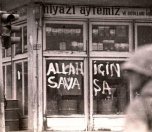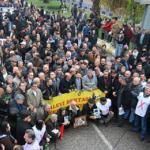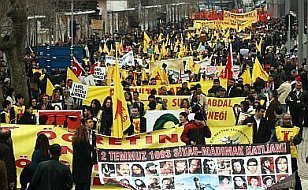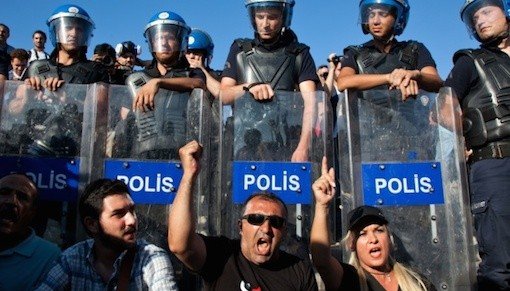Eight hundred and four defendants stood trial for participating in the December 1978 massacre in Maraş which according to official figures left 111 dead and a thousand people injured. The Martial Law Military Court No. 1 (Adana, Kahramanmaraş, Gaziantep, Adıyaman, Hatay İlleri Sıkıyönetim Askeri Komutanlığı 1 Numaralı Askeri Mahkemesi) convened in a sports hall in Adana to hear the case. For the first time the proceedings which ran on consecutive days were taped and full transcriptions running to thousands of pages produced.
Although thirteen provinces of the country were put under martial law in direct response to the Maraş massacre, this did little to guarantee security of life. Political assassinations continued to occur on a daily basis; just in the course of the trial three lawyers acting for the victims of the massacre (mudahil avukat) were murdered, and the others faced death threats and were obliged to switch their places of lodging in Adana for the duration of the proceedings.
A number of defendants were sentenced to life imprisonment, though all were released by 1992. The court never probed the evidence and circumstances to discover what lay behind the massacre, how it was planned and by whom.
Discussing and explaining the December 1978 massacre in Maraş has been largely confined to Alevi and leftist circles. There has been little wider discussion, apart from by some on the far right associated with the events. For those who have discussed the events, the overwhelming focus has been on the fact of the killings being the result of a planned conspiracy, the work of rightists and allegedly deep state elements. In some quarters it is even argued to have been the work of international intelligence agencies. That the military court made no attempt to get to the bottom of the incidents has of course fuelled this speculation about the dimensions of the conspiracy.
The fixation on the conspiracy itself, however, has been at the expense of confronting the human tragedy and the fact that the actual perpetrators of the killings were not only a group of conspirators. Rather they were ordinary people, villagers and townsfolk who became capable of horrific acts of torture and murder of young and old, women and men. Among the defendants were local muhtars and imams. It is difficult to resist the view that the conspirators behind the killings must themselves have been surprised at the dimensions this massacre took on.
The massacre was triggered by a series of events including the bombing of a cinema and the murder and then funerals of two teachers. The victims were mainly singled out for being Alevi and leftist/CHP voting. For nationalists and rightists, a simple understanding of leftist or communist political affiliations viewed them as atheist ideologies which threatened to an entire religious moral order. Converging left identity with Alevi seemed to provide the proof of this threat. The accounts of the killings bear out the fact that the question of religious affiliation became central as a means of demarcating who needed to be purged. Witnesses testified in court that victims were frequently asked by their assailants to prove that they were Muslim and Turkish.
Explanations of the Maraş incidents tended to resist examining the responsibility of the local population for what happened by focusing on a “hidden hand” in the events, blaming everything on outsiders, or simply insisting on an age-old “brotherhood” of Alevi and Sunni (a slightly apologetic “we are all brothers”/”hepimiz kardesiz”). In Maraş a silence hangs over the incidents of 1978. There has been no attempt to confront what happened. The incidents have been subjected to a collective forgetting in which it is not even possible for most people in the town today to empathize with the victims of the massacre. It is more readily admitted that the incidents were damaging to the town than to a part of its population. A great majority of the Alevi population left the town after the incidents.(ESW/EÜ)











